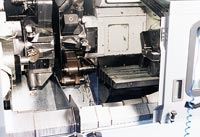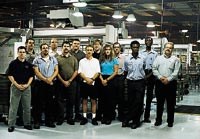Manufacturer Takes Innovative Approach To Advanced Manufacturing Processes
Thousands of contract manufacturing shops across North America that produce commodity parts such as shafts, arbors, bearing races, gear splines, and so on, have one problem in common: how to do it faster and less expensively.
Share




Thousands of contract manufacturing shops across North America that produce commodity parts such as shafts, arbors, bearing races, gear splines, and so on, have one problem in common: how to do it faster and less expensively. Fifty-year-old Precision Group Inc. (Rockford, Illinois) believes it has found the solution.
Raymond Shaw, vice president of marketing for PGI, says that the company takes an innovative approach to manufacturing commodity parts. It uses advanced automation such as robots to reduce labor, and it has the most advanced machine tools available running 22 hours a day, seven days a week to gain productivity. PGI realized that to expand and produce world-class products efficiently it needed to manufacture its commodity parts differently. To do this, the Team Key concept was developed, emphasizing a total culture change in the company. Team Key is the synergy of key stakeholders (equipment vendors, PGI and the customer). Now the company is product focused, responsibility and risk between team members are shared, and strengths and capabilities of the team members are built upon daily.
“Our ability to design and build the necessary tooling, develop the prototype and take a part into highvolume production has proved a real benefit,” says David Morgan, president and CEO, of the Team Key approach.
Now PGI looks at the entire process of part production to optimize it and the end product. It works with the drawings customers provide, raw materials from suppliers, internal purchasing and scheduling, machine tools used for the work, tooling for the equipment, secondary operations such as grinding and deburring, and final JIT delivery to the customer.
With the Team Key concept, in November 1997, PGI gained a large multiyear contract from a major customer to produce diesel engine shafts. During the conception of this project, PGI realized its inability to handle the increase of the work associated with this project using its existing singlespindle CNC lathes. So began the search for the most advanced machine tools to accomplish the goals set by the customer for this project.
PGI researched four companies that had machine tools that could meet its initial needs. As a turnkey concept, the competing companies suggested the equipment and processes to produce the parts.
PGI decided to purchase three new Mazak Multiplex 630 twinspindle/twinturret multitasking turning centers with live tooling for milling, drilling and tapping from Mazak (Florence, Kentucky). Integrated robot part handling using Mazak GL200N Gantry Robot Loader/Unloader Systems is also used. PGI put the Team Key concept to work with Mazak, too. MSI, the Chicago, Illinois, distributor for Mazak Corp., worked as a team with PGI and Mazak to select the proper equipment for the manufacturing and a production system. PGI wanted the most advanced machining technology available, and the Multiplex 630 multitasking machines had the features and benefits needed.
PGI consolidated the machines in a 3,500 sq. ft. area for efficient workflow. Now in this area, raw parts are brought in and placed on special pallets. The pallets are loaded into the machines and the robot handling equipment moves the parts from the pallet to the spindle while delivering finished parts back to the pallet with the use of two separate grippers on opposite sides of the robot handler. Next, the cut parts are deburred and then sent out for heat-treating. From the heat treater they are returned and ground to final tolerances. Throughout the operations, parts are consistently checked for proper part dimensions. PGI also has its own inhouse Magnaflux capabilities. Some of the shaft work demands 100 percent inspection including checks for surface cracks.
Mr. Anderson explained that Mazak’s Multiplex 630 offered all the capabilities of a vertical machining center and a lathe in one unit with the spindle power needed. With its twin spindles and twin turrets, it can machine both sides of a part with an automatic inmachine handoff to the second spindle. With live tooling for tapping, drilling and milling it can complete a part without any secondary operations.
Mr. Anderson says that keeping the parts in one machine is extremely important. First there is no need to take the part from a turning operation to a secondary operation. So it actually eliminates the need for extra machine tools and their costs. It also eliminates the fixtures for these operations and the costs and time needed to build them. Because there is less handling and no fixture induced errors, scrap and the expenses associated with the scrap are drastically reduced.
Mr. Andersen added that another way to compress manufacturing time and save costs with the Multiplex is in part changes. If a part modification or redesign has to be made, all it usually takes is a program change. There’s no need to redesign and build new fixtures. The 200,000 parts per year now manufactured on the Mazak Multiplexes were originally done on single spindle CNC lathes and mills. Production has increased by 30 percent because of greater throughput. The five part numbers produced on the Multiplexes fit in a 6-inch by 6-inch by 6-inch envelope. They are all made from either 4120 or 4118 steel.
Mazak’s Multiplex 630 has a 12-inch chuck. Maximum cutting length for chuck work is 25.6 inches. Main spindle motors produce 30 hp with speeds of up to 3,000 rpm. A 10-hp rotary tool spindle motor on the turret can produce speeds up to 1,500 rpm offering performance comparable to a machining center for secondary operations.
Each spindle has a 12position drum turret, which indexes in 0.9 sec./onestep (2.2 sec./full step). Rapid traverse rate for the X and Z axes is 945 ipm and for the C axis is 100 rpm.
The Multiplex Robot Loader/Unloader System’s gripping diameter for chuck workpieces is 1.97 inches to 11.81 inches. For shaft workpieces it is 0.79 inch to 4.72 inches. Each robot hand gripper can hold a part as heavy as 22 lbs. The user interface is the Windows 95 operating system, giving Mazatrol Fusion 640 bidirectional communication capabilities between its fused PC and CNC and other factory PCs. MMS
Related Content
Translating a Prototyping Mindset to Production
The experimental mindset that benefited BDE Manufacturing Technologies as a prototype job shop has given it an adaptable edge as a production facility.
Read More3 Ways Artificial Intelligence Will Revolutionize Machine Shops
AI will become a tool to increase productivity in the same way that robotics has.
Read MoreInvesting in Automation, Five-Axis to Increase Production Capacity
To meet an increase in demand, this shop invested heavily in automation solutions and five-axis machines to ramp up its production capabilities.
Read More4 Steps to a Cobot Culture: How Thyssenkrupp Bilstein Has Answered Staffing Shortages With Economical Automation
Safe, economical automation using collaborative robots can transform a manufacturing facility and overcome staffing shortfalls, but it takes additional investment and a systemized approach to automation in order to realize this change.
Read MoreRead Next
Building Out a Foundation for Student Machinists
Autodesk and Haas have teamed up to produce an introductory course for students that covers the basics of CAD, CAM and CNC while providing them with a portfolio part.
Read MoreSetting Up the Building Blocks for a Digital Factory
Woodward Inc. spent over a year developing an API to connect machines to its digital factory. Caron Engineering’s MiConnect has cut most of this process while also granting the shop greater access to machine information.
Read More5 Rules of Thumb for Buying CNC Machine Tools
Use these tips to carefully plan your machine tool purchases and to avoid regretting your decision later.
Read More






















.jpg;maxWidth=300;quality=90)
















